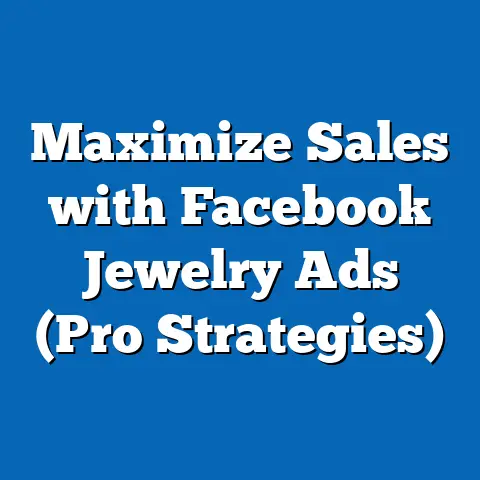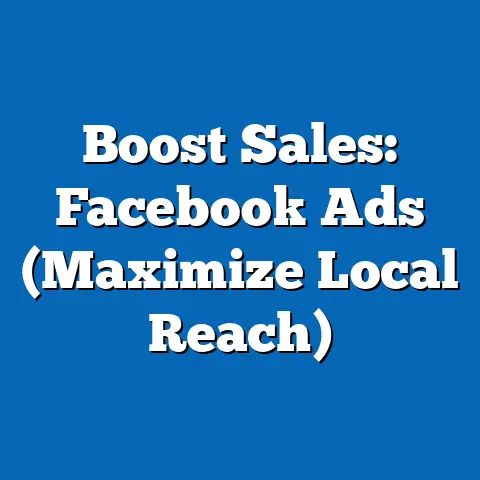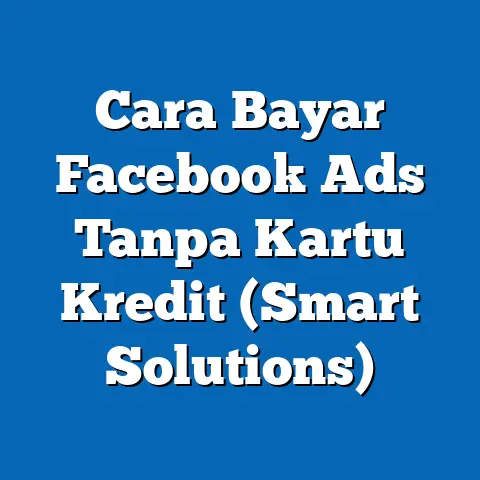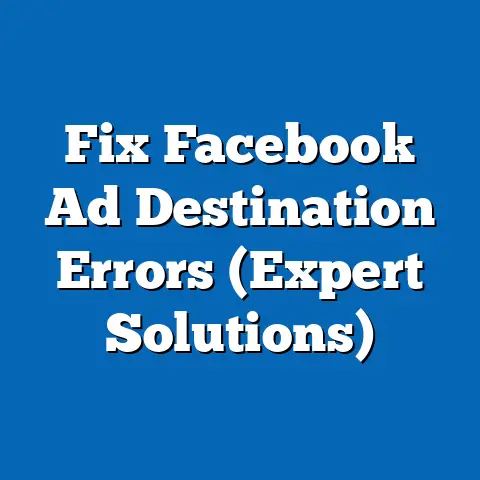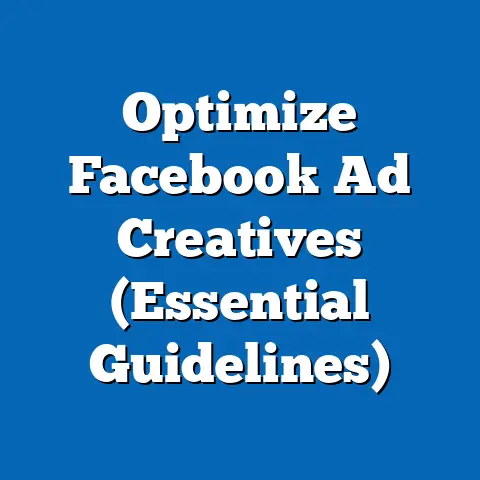Unlock the Best Facebook Ads Course (Expert Insights Inside)
In an era where sustainability and digital innovation intersect, the demand for eco-friendly marketing strategies has surged, with businesses increasingly seeking ways to align their advertising efforts with environmental consciousness. A 2022 report by Nielsen revealed that 73% of global consumers are willing to change their consumption habits to reduce environmental impact, a statistic that extends to how they perceive brands and their advertising practices. This trend has fueled interest in digital marketing platforms like Facebook Ads, which offer targeted, paperless advertising solutions, minimizing the carbon footprint compared to traditional print media.
The Rise of Eco-Friendly Marketing: Statistical Trends
The push for sustainability in marketing is no longer a niche movement but a mainstream expectation. According to a 2023 study by Statista, 66% of consumers worldwide are willing to pay more for sustainable brands, up from 55% in 2015. This growing consumer preference has led companies to pivot toward digital advertising, with platforms like Facebook Ads becoming a cornerstone due to their efficiency and reduced environmental impact.
Digital advertising, unlike traditional methods such as billboards or direct mail, eliminates the need for physical materials, cutting down on paper waste and energy consumption associated with production. A report by the Digital Marketing Institute in 2022 highlighted that digital ad spending globally reached $522 billion, with social media platforms like Facebook accounting for nearly 20% of that figure. This shift not only reflects a cost-effective strategy for businesses but also aligns with eco-conscious values, as digital ads produce 70% less CO2 emissions per impression compared to print ads, per a 2021 study by Carbon Trust.
Moreover, businesses adopting green marketing strategies report a 15% increase in customer loyalty, according to a 2023 survey by McKinsey & Company. As sustainability becomes a competitive advantage, mastering platforms like Facebook Ads—through targeted, data-driven campaigns—offers a dual benefit: reaching vast audiences while maintaining an eco-friendly brand image. The demand for expertise in this area has, in turn, spurred a surge in educational resources, with Facebook Ads courses becoming a critical tool for marketers aiming to stay ahead of the curve.
Demographic Breakdown: Who’s Driving the Eco-Friendly Marketing Shift?
The shift toward sustainable marketing and digital advertising isn’t uniform across all demographics; certain groups are leading the charge. Millennials (ages 27-42 in 2023) and Gen Z (ages 11-26) are the most vocal advocates for eco-friendly practices, with 75% of Millennials and 80% of Gen Z expressing a preference for brands with strong sustainability commitments, as reported by a 2022 Deloitte survey. These generations, who collectively make up 48% of the global population according to UN data, are also the most active on social media, with 90% of Gen Z and 85% of Millennials using platforms like Facebook daily (Pew Research Center, 2023).
Geographically, consumers in Europe and North America are at the forefront of demanding sustainable marketing practices. A 2023 Eurobarometer survey found that 68% of EU citizens consider environmental impact when making purchasing decisions, compared to 62% in the United States, per Nielsen data. This contrasts with emerging markets in Asia and Africa, where awareness is growing but only 40-45% of consumers prioritize sustainability due to economic constraints, according to a 2022 World Bank report.
In terms of business demographics, small and medium-sized enterprises (SMEs) are increasingly adopting digital tools like Facebook Ads to compete with larger corporations while maintaining eco-friendly practices. A 2023 report by the International Trade Centre noted that 60% of SMEs in developed economies have shifted at least 50% of their marketing budgets to digital platforms, citing both cost savings and sustainability as key motivators. For these businesses, learning to navigate Facebook Ads through specialized courses is often a game-changer, enabling precise targeting without the environmental cost of mass print campaigns.
Historical Comparisons: From Traditional to Digital Advertising
To understand the significance of platforms like Facebook Ads in today’s eco-conscious landscape, it’s essential to compare current trends with historical data. In the 1990s, traditional advertising—comprising print, television, and radio—dominated the market, accounting for over 90% of global ad spend, according to eMarketer historical data. Print advertising alone consumed an estimated 1.2 million tons of paper annually in the U.S., contributing to deforestation and high carbon emissions, as reported by the Environmental Protection Agency (EPA) in 1998.
By contrast, the early 2000s marked the beginning of a digital revolution, with online ad spending growing from $6 billion in 2000 to $124 billion by 2010, per Statista. The launch of Facebook Ads in 2007 was a pivotal moment, offering businesses a way to reach specific audiences without the waste associated with broad, untargeted traditional campaigns. By 2015, digital ad spending surpassed traditional methods for the first time, reaching 51% of total global ad budgets, a trend that has only accelerated with a reported 70% share in 2023 (eMarketer).
Environmentally, this shift has had measurable impacts. A 2019 study by the Global Carbon Project estimated that the transition to digital advertising reduced the industry’s carbon footprint by 25% between 2005 and 2015, largely due to decreased reliance on paper and physical distribution. Facebook Ads, with its emphasis on data-driven targeting, has played a significant role in this reduction, making it a preferred choice for brands aiming to balance profitability with sustainability—a skillset now taught in specialized courses.
The Role of Facebook Ads in Sustainable Marketing
Facebook Ads has emerged as a powerful tool for eco-friendly marketing, offering features like hyper-targeted campaigns that reduce wasted impressions and energy use compared to traditional scattershot approaches. As of 2023, businesses using Facebook Ads report a 30% higher return on ad spend (ROAS) compared to other digital platforms, according to a study by Hootsuite. This efficiency translates to fewer resources spent on ineffective ads, aligning with sustainability goals.
Moreover, Meta has committed to sustainability at the corporate level, achieving net-zero carbon emissions for its operations in 2020 and pledging to support renewable energy projects. A 2022 report from Meta stated that 100% of its data centers are powered by renewable energy, a fact that resonates with eco-conscious brands using the platform. For marketers, learning to leverage Facebook Ads not only boosts campaign performance but also aligns with broader environmental objectives—knowledge that the best courses emphasize through practical, real-world applications.
However, mastering Facebook Ads requires understanding complex algorithms, audience segmentation, and creative optimization, areas where many businesses falter without proper training. A 2023 survey by Social Media Examiner found that 65% of marketers struggle with creating effective ad content on the platform, highlighting the need for structured education. This gap has fueled the rise of Facebook Ads courses, which provide step-by-step guidance on building sustainable, high-impact campaigns.
Choosing the Best Facebook Ads Course: Expert Insights
With the proliferation of online learning options, selecting the right Facebook Ads course can be daunting. Experts agree that the best courses combine theoretical knowledge with hands-on practice, focusing on real-world applications like creating eco-friendly campaigns that resonate with target audiences. Here, we break down key criteria for choosing a course, based on insights from industry leaders and data from platforms like Udemy, Coursera, and independent providers.
First, look for courses with updated content reflecting the latest Facebook Ads features and policies, as the platform evolves rapidly. A 2023 analysis by Digital Marketing Institute found that 40% of online courses contain outdated material, rendering them less effective for current market needs. Top-rated courses, such as those by Jon Loomer or Amy Porterfield, are frequently updated and include modules on sustainability in digital marketing—a growing focus area.
Second, prioritize courses offering practical tools like ad simulators or live campaign analysis. According to a 2022 survey by LinkedIn Learning, 78% of learners retain information better through interactive content, making hands-on courses more effective. Programs that provide access to case studies of eco-conscious brands using Facebook Ads can offer unique insights into balancing profitability with environmental responsibility.
Third, consider instructor credibility and community support. Courses led by certified professionals with proven track records—often verified through reviews or endorsements—tend to offer more value. For instance, the “Facebook Ads Mastery” course by a recognized digital marketing expert boasts a 4.8/5 rating on Udemy from over 10,000 reviews as of 2023, with many learners citing the instructor’s focus on ethical advertising as a standout feature.
Finally, assess cost versus value. While free courses are widely available, they often lack depth; premium courses priced between $50 and $200 typically offer comprehensive content and lifetime access to updates. A 2023 report by eLearning Industry noted that paid courses have a 60% higher completion rate compared to free ones, suggesting a stronger commitment from learners.
Statistical Impact of Facebook Ads Training on Business Outcomes
Investing in a quality Facebook Ads course can yield significant returns for businesses, particularly those prioritizing sustainable marketing. A 2022 study by HubSpot found that businesses whose marketers completed specialized social media training saw a 25% increase in campaign conversion rates and a 20% reduction in ad spend waste. For SMEs, this translates to substantial cost savings and a stronger alignment with eco-friendly goals through targeted, efficient advertising.
Demographically, younger marketers (under 35) are more likely to seek out such training, with 70% reporting a desire for upskilling in digital tools like Facebook Ads, per a 2023 LinkedIn report. In contrast, only 45% of marketers over 50 expressed similar interest, often citing familiarity with traditional methods as a barrier. This generational divide underscores the importance of tailored educational content that addresses varying levels of tech-savviness.
Geographically, adoption of Facebook Ads training is highest in North America and Europe, where 55% of digital marketers have completed at least one course, according to a 2023 Statista survey. In contrast, only 30% of marketers in Asia-Pacific and 25% in Latin America have accessed similar training, often due to language barriers or cost constraints. Bridging this gap through affordable, localized courses could further democratize access to sustainable marketing skills.
Future Projections: The Evolution of Eco-Friendly Marketing and Facebook Ads
Looking ahead, the intersection of sustainability and digital advertising is poised for significant growth, with implications for both businesses and educational providers. By 2027, global digital ad spending is projected to reach $740 billion, with social media platforms like Facebook expected to capture 25% of that market, according to eMarketer forecasts. This growth will likely be driven by increased consumer demand for transparency and eco-friendly practices, pushing brands to refine their digital strategies.
On the training front, the demand for Facebook Ads courses is expected to rise by 35% annually through 2028, per a 2023 report by Research and Markets. This surge will likely be accompanied by a greater emphasis on sustainability modules, as businesses seek to differentiate themselves in a crowded market. Courses that integrate topics like carbon-neutral campaign planning or ethical audience targeting are likely to gain traction, reflecting broader societal shifts.
Environmentally, the continued shift to digital platforms could further reduce the advertising industry’s carbon footprint by an estimated 15% by 2030, according to projections by the Global Carbon Project. However, challenges remain, including the energy consumption of data centers and the need for broader access to renewable energy. Meta’s ongoing commitment to sustainability will play a critical role in shaping how platforms like Facebook Ads contribute to these goals.
For marketers and businesses, the implications are clear: mastering Facebook Ads through high-quality training isn’t just a competitive advantage—it’s a pathway to aligning with consumer values and environmental priorities. As the landscape evolves, staying ahead will require continuous learning, adaptability, and a commitment to sustainability at every level of marketing strategy.
Conclusion
The convergence of eco-friendly marketing and digital platforms like Facebook Ads represents a transformative opportunity for businesses worldwide. With 73% of consumers prioritizing sustainability and digital ad spending dominating global budgets at 70%, the need for expertise in tools like Facebook Ads has never been greater. Demographic trends show Millennials and Gen Z leading the charge, while historical data underscores the environmental benefits of moving away from traditional advertising.
Choosing the best Facebook Ads course—guided by expert insights and data-driven criteria—can empower marketers to create impactful, sustainable campaigns that resonate with modern audiences. As we look to the future, projections suggest continued growth in both digital advertising and the demand for specialized training, with sustainability remaining a core focus. For businesses and individuals alike, unlocking the potential of Facebook Ads isn’t just about driving results—it’s about building a better, greener future.


